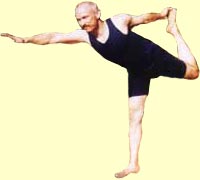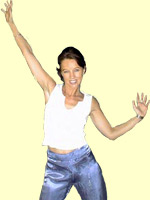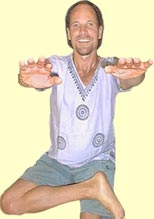|
The ancient practice of yoga sprang into popularity as part of the New Age movement over some thirty years ago. But, unlike other movements that became just another fad, yoga has proved its staying power and managed to survive entry into the new millennium. In fact, as an increase in adherents attests, it's more than surviving; it's positively thriving.
In 2001 it was spotlighted, both by the Oprah Winfrey show and as the cover story on a Time magazine – the lithe and lovely Christy Turlington sporting a taut tum while perched in her rooster pose (something I'm too chicken to try!)
In spite of the skepticism of the scientific community, practitioners swear by it for maintaining and restoring health, for keeping bodies trim and flexible and minds becalmed.
According to Osho, yoga can become "the supreme science" – if it embraces some new elements, which are needed if it is to be effective for contemporary men and women.
At any given time, among the numerous visitors at the Osho Meditation Resort in Pune, India. there are always yoga adherents (or ex-adherents). "I promised my yoga teacher I'd keep my practice up while I was away," confesses one, looking a little embarrassed, "and you know, since I've been here I haven't even thought about it."
Three enthusiasts – all of them visiting the resort for the first time – were asked for their take on yoga in the light of their introduction to the active meditative methods.
 Joe Roberson is a teacher at the Yoga School in Columbia, Maryland. He is also a professional photographer and father of three boys. He is clear about why he was drawn to yoga...and why now he needs to change tack Joe Roberson is a teacher at the Yoga School in Columbia, Maryland. He is also a professional photographer and father of three boys. He is clear about why he was drawn to yoga...and why now he needs to change tack
"For myself, the attraction of yoga arose out of control issues – a need to control my body and my emotions. The lesson I had learnt in life was: Express emotions and you are out of control and you can be hurt.
"Through yoga I achieved that control to a certain extent. But now I'd like to be not strategizing and controlling so much...because those tendencies have taken over my life. Now I want to be balanced, relaxed...enjoying more"
In India to visit the Iyengar yoga center, he found time to check out the Osho Meditation Resort, and began to try out the active methods. He expresses his change of understanding, as a result of this experiment:
"While yoga can induce harmony among the many organs and systems of the bodymind complex, the problem lies with unconscious memories, buried traumas, painful experiences and/or repressed emotions, which are not so easily exorcised. For these, it is my experience that cathartic, chaotic methods are far more effective even than other contemporary approach, such as Anusara Yoga.
"The chaotic methods emphasize spontaneous emotional expression, rather than only positive expression. Prescribed joy merely becomes another 'should," whereas the Osho emphasis is on authentically engaging with whatever you feel – whether joy, rage, sadness or madness. Suppressing any emotion, any trauma, any 'inappropriate' feeling only adds to the heap of suppressions that keep us from being fully present, fully alive.
"Dynamic meditation provides a safe structure for the expression of any and all emotional energies. Only when the armoring of accumulated tension and suppression have been released is there genuine grace, peacefulness, and the joy and celebration of being alive here and now. Osho Dynamic has proven to be the best technique for – as one student put it – 'sloughing off the toxic tensions of the week.' It is 'industrial-strength cleanser' for the emotional body."
 Thirty-seven year old Amanda Hucks is a lively, outgoing psychotherapist from London who has been practicing yoga for years. She said that initially she found it "took me to a quiet place and, because I am fit and pretty flexible anyway, the positions were easy to do. The teachers would use nice music and, because it was Iyengar Yoga, the stretches were slow, not like with Hatha Yoga. Thirty-seven year old Amanda Hucks is a lively, outgoing psychotherapist from London who has been practicing yoga for years. She said that initially she found it "took me to a quiet place and, because I am fit and pretty flexible anyway, the positions were easy to do. The teachers would use nice music and, because it was Iyengar Yoga, the stretches were slow, not like with Hatha Yoga.
"But in my yoga class I felt a spirit of competitiveness and ambition around how many different positions you can do. So if you can't do a posture and if you don't you feel there is something wrong with you."
By contrast, Joseph says, "I've had limited exposure to those in the Osho orbit, but my impression is that spiritual egoism is less prevalent. If you go along with Osho's suggestion of practicing laughter, especially about oneself, of not taking anything too seriously, then spiritual arrogance can't take root."
American Robert Polsky, an entrepreneur and yoga instructor, found that his energy was becoming increasingly stuck through practicising the headstand.
"I already had a problem with too much energy in the head – as many people do – and it got progressively worse. I got ringing in my ears, my eyes were bloodshot, and the insomnia I was suffering from became worse."
 Robert later switched to Bikram Yoga, which he enjoyed because it not only had the health benefits and increased flexibility, it also built strength. Robert later switched to Bikram Yoga, which he enjoyed because it not only had the health benefits and increased flexibility, it also built strength.
"In spite of that, when I began Osho Dynamic Meditation at the resort I still had a lot of frozen energy in my back and shoulders. I also had so much pain in my neck that it was difficult to even hold my arms above my head in the third stage of jumping. That took me by surprise and I felt like such a wimp!
"Over months of Dynamic, Kundalini and various courses, that frozen energy was released. So there was a real release of energy blocks, a real transformation."
Robert especially appreciates the element of celebration in the active meditations, saying, "nothing like that exists in any system. It's the element that keeps meditation light-hearted, and that's important. Yoga practitioners do tend to get a little serious about what they're doing, especially if their practice is belief-based or associated with a guru."
Robert sees a synthesis between yoga and the Osho active methods working. "I think the active methods could go over very well in gyms, martial arts dojos and yoga schools – if those people don't feel that their own practice is threatened. If people can find an hour's space where they can get some relief of stress, I see Osho Dynamic as more effective than yoga."
"There are many different forms of yoga and of meditation," concludes Joseph. "As Osho says, if one teacher or style does not suit you, don't waste time and energy blaming the teacher or the system. Just move on, and keep moving until you find the approach that feels right and makes sense to you.
"Yoga addresses physical health and vitality well, while the Osho meditative techniques work more directly with emotions. Together they make a great combination, offering more than either does separately."
Copyright © Osho Times Asian |
|

